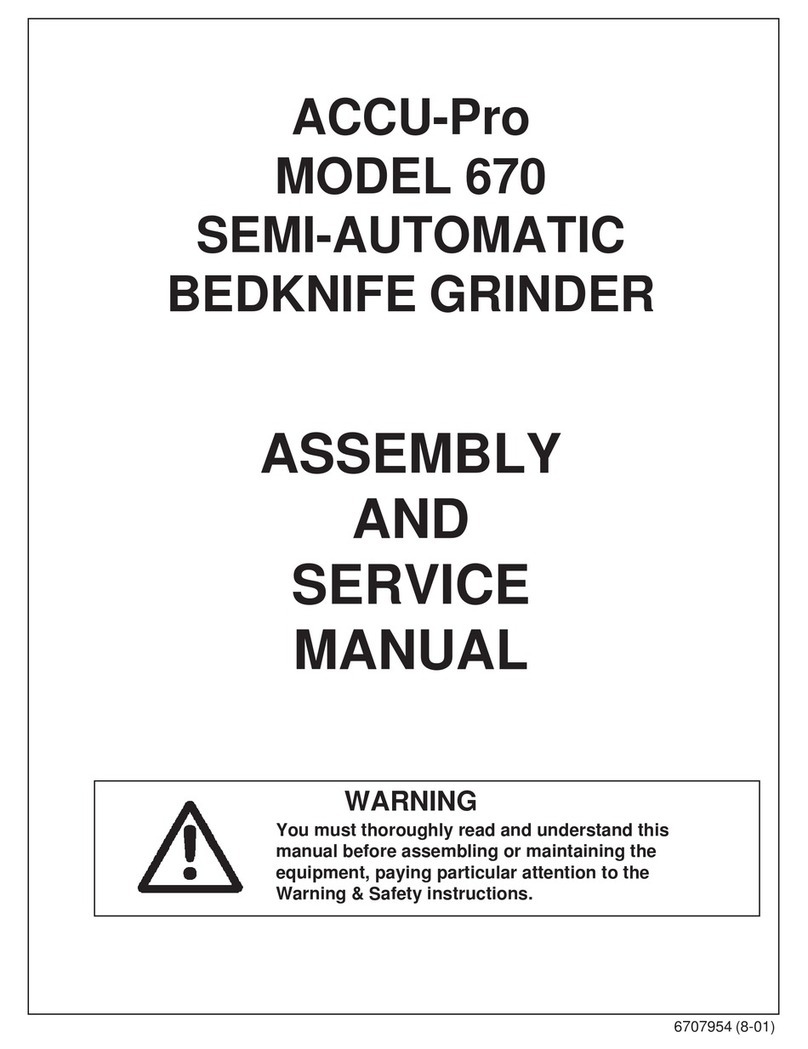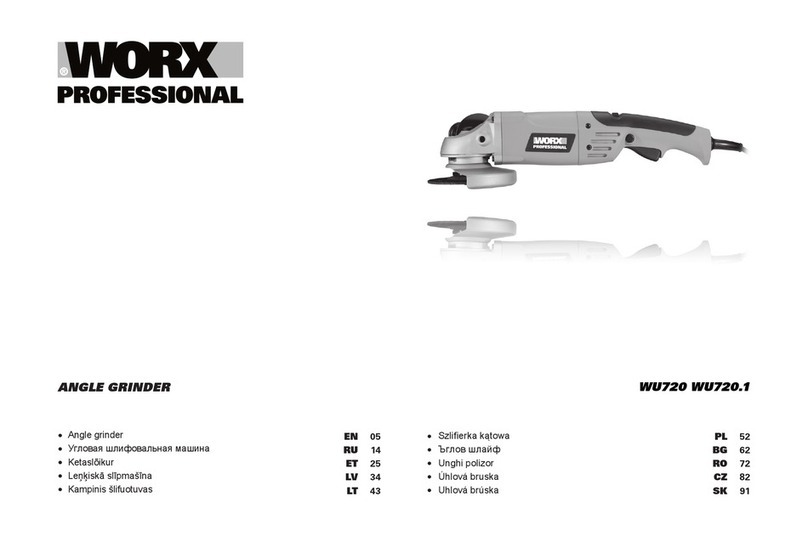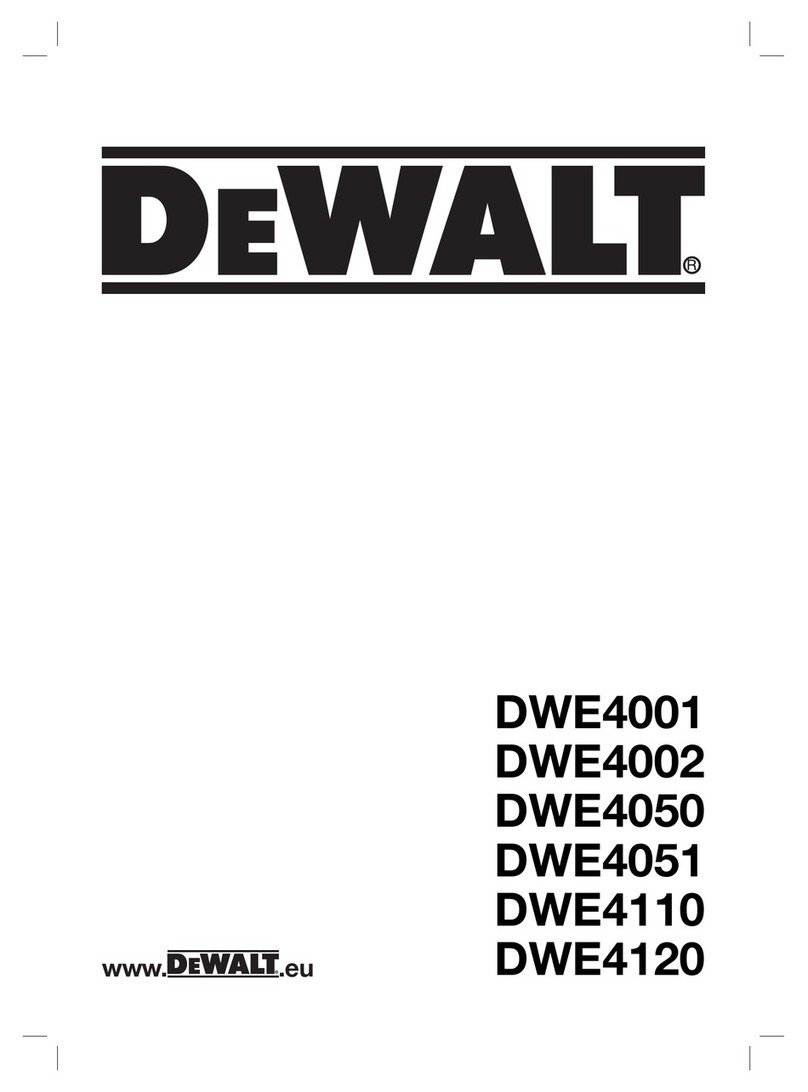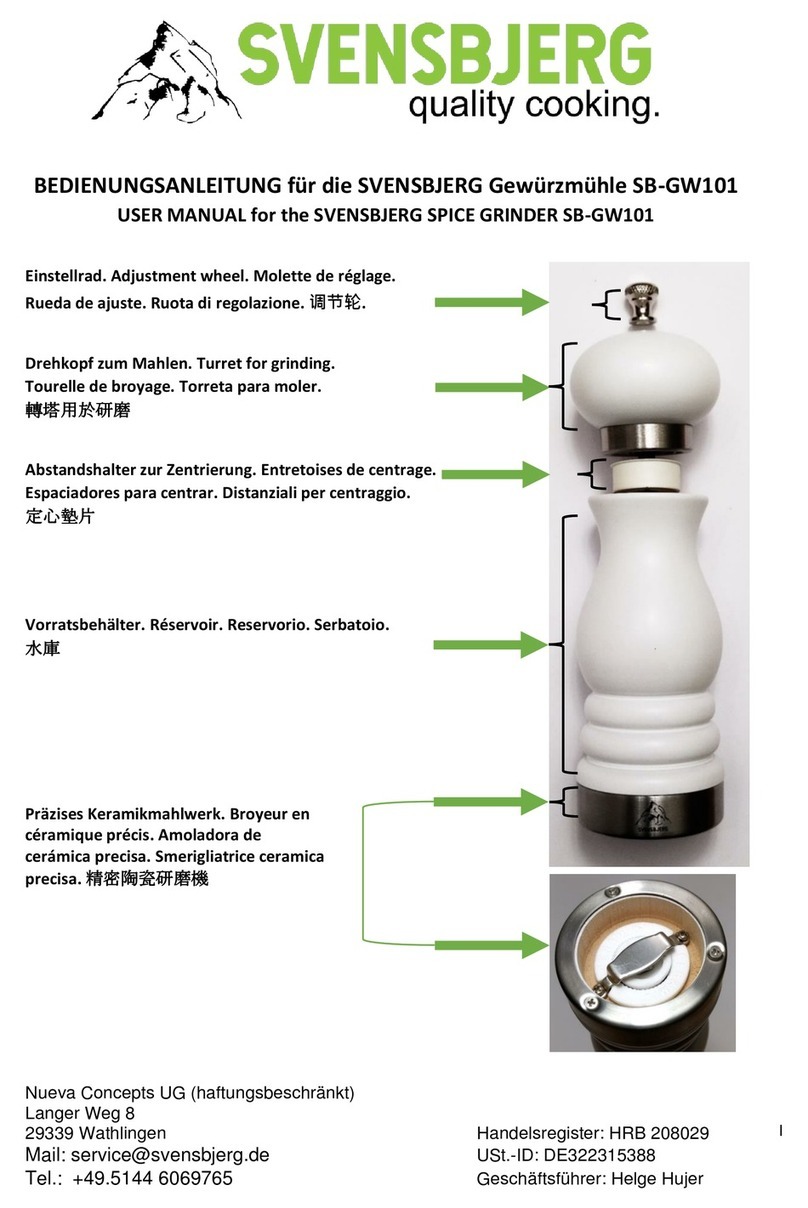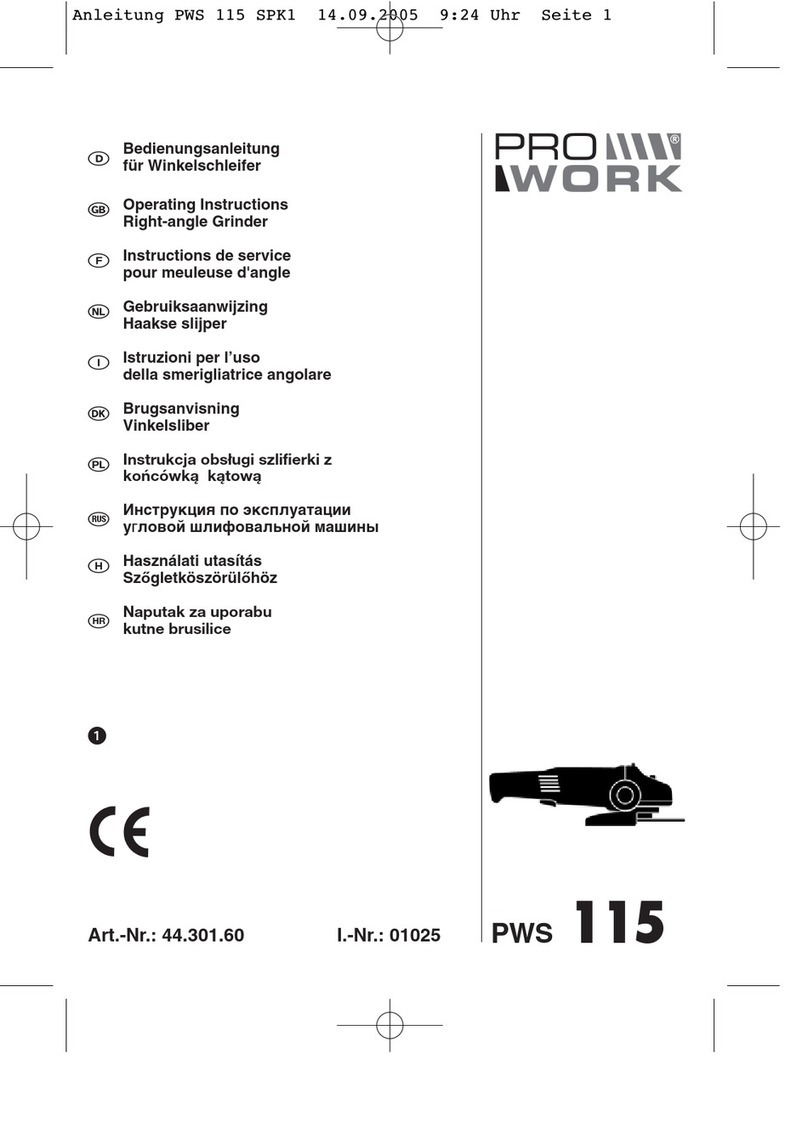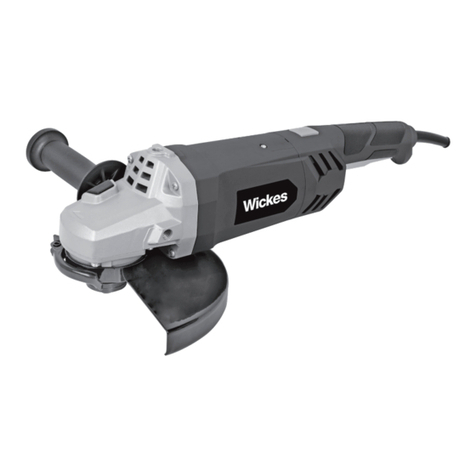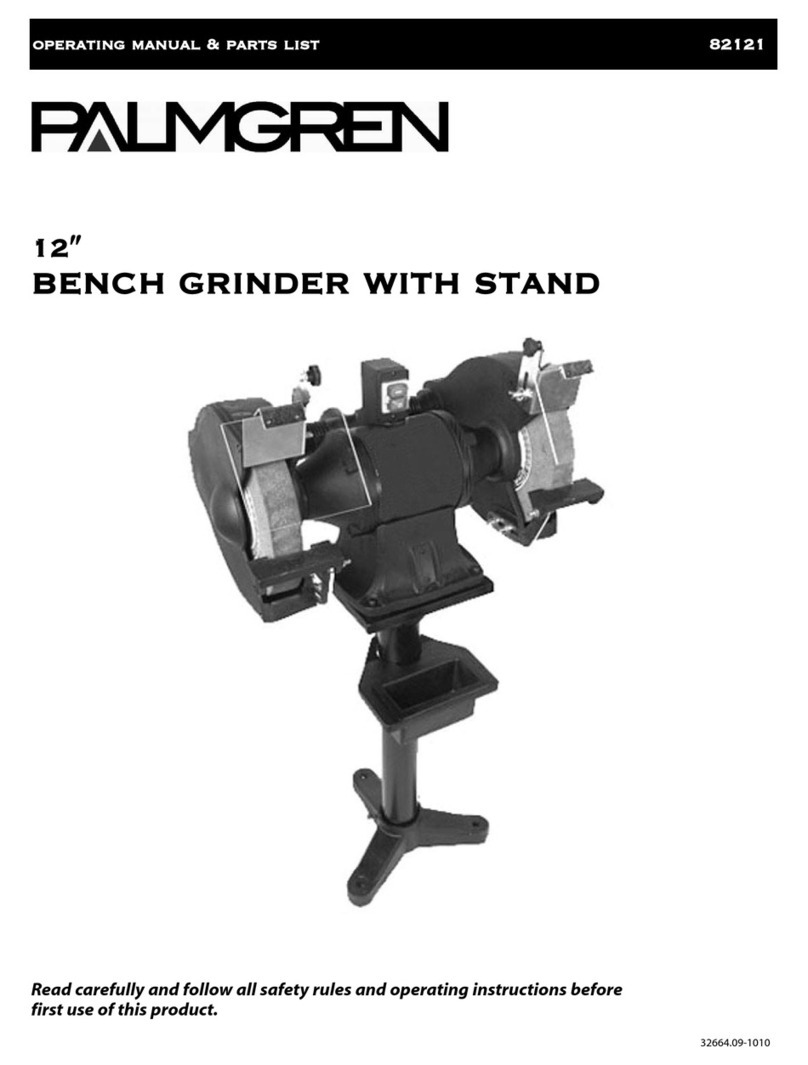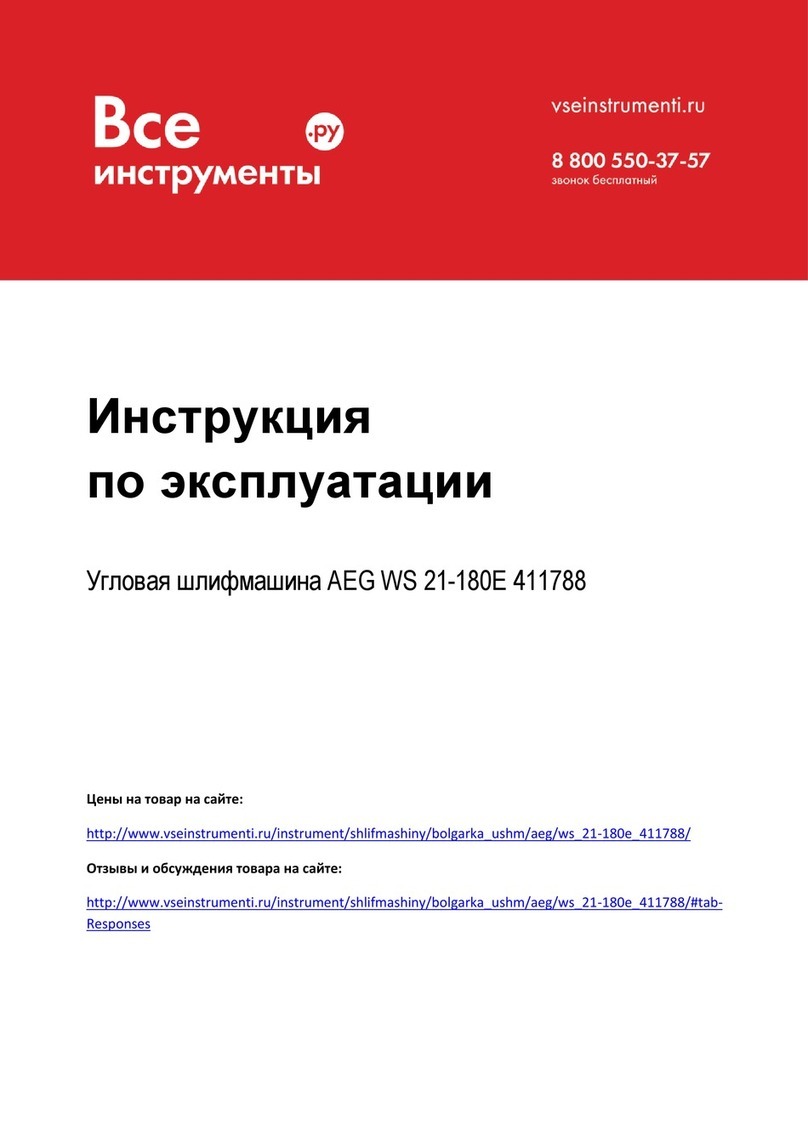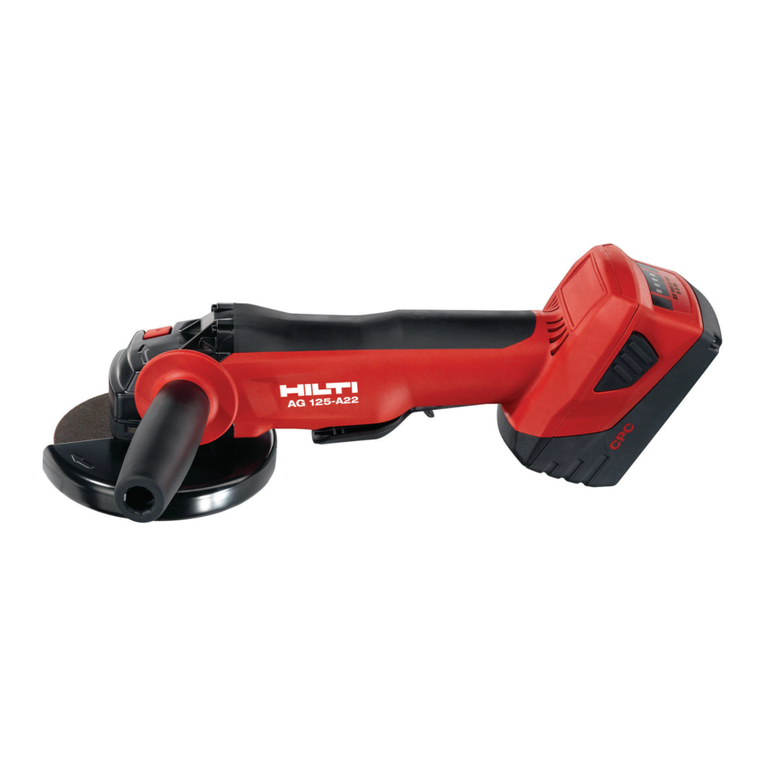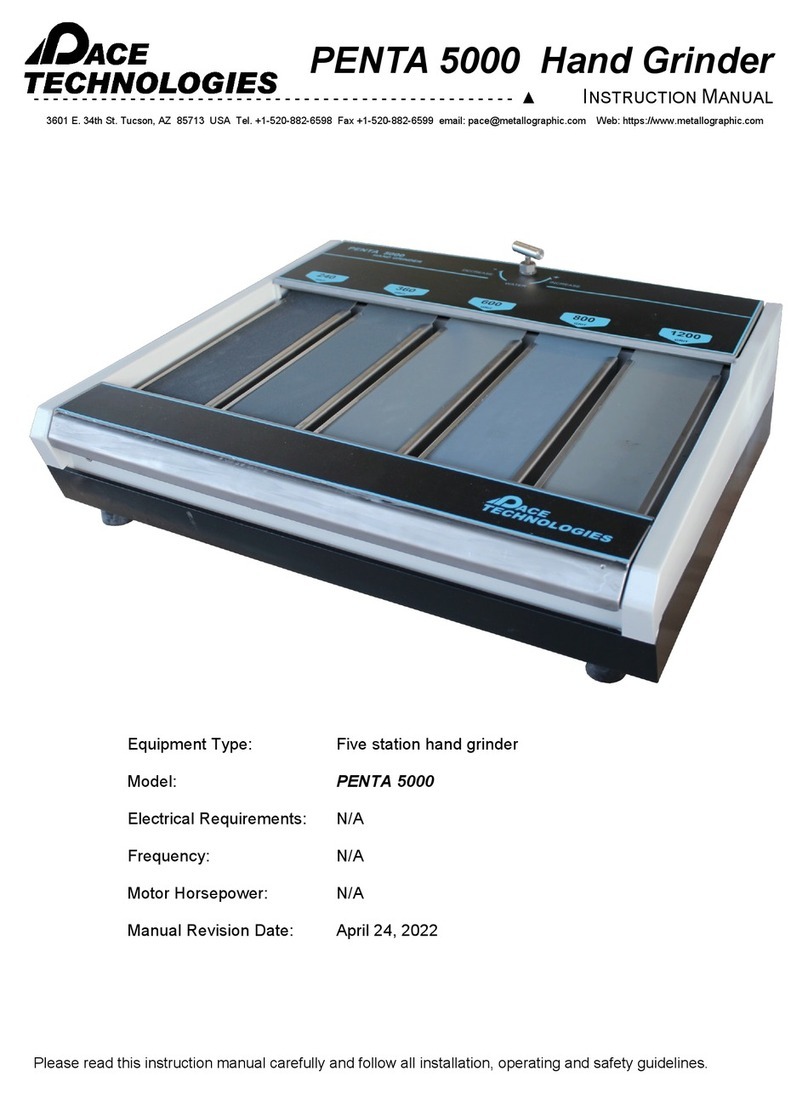Foley United 384 User manual

1
This book consists of two manuals:
The OPERATORS MANUAL which contains all the
information on operating and doing routine daily
maintenance on this equipment.
The ASSEMBLY and SERVICE MANUAL which is
used by the maintainence department to install the
equipment and to do all maintenance except routine
daily maintenance.
Setting the Standard With the
World's Most Valued Grinders.
384
MANUAL
BEDKNIFE GRINDER

2
W e are committed to:
Providing superior customer support, training,
and service.
Manufacturing the highest quality products at an
unequaled value.
Setting the industry standard by investing in
technological product innovation.
Manufacturing products specifically designed to
maintain original equipment manufacturers'
specifications.
Interacting with and supporting all original
equipment manufacturers.
Setting the Standard With the World's Most Valued Grinders.

3
384
MANUAL
BEDKNIFE GRINDER
OPERATORS
MANUAL
3847953 (7-03)
WARNING
Youmustthoroughlyread and understandthismanual
beforeoperatingtheequipment, paying particular
attentionto the Warning& Safetyinstructions.

4
SAFETY INSTRUCTIONS
Safety Awareness Symbols
are inserted into this
manualtoalertyoutopossible
Safety Hazards
. When-
everyouseethesesymbols,followtheirinstructions.
The
Warning Symbol
identifies special instructions
or procedures which, if not correctly followed, could
result in personal injury.
The
Caution Symbol
identifies special instructions
or procedures which, if not strictly observed, could
result in damage to or destruction of equipment.
1. KEEP GUARDS IN PLACE and in working
order.
2. REMOVE WRENCHES AND OTHER
TOOLS.
3. KEEP WORK AREA CLEAN.
4. DON'T USE IN DANGEROUS ENVIRONMENT
.
Don't use Grinder in damp or wet locations.
Grinder is for indoor use only. Keep work area
welllit.
5. KEEP ALL VISITORS AWAY
.
All visitors
should be kept a safe distance from work area.
6. MAKE WORK AREA CHILD-PROOF with
padlocks or master switches.
7. DON'T FORCE THE GRINDER. It will do the job
better and safer if used as specified in this
manual.
8. USE THE RIGHT TOOL. Don't force the Grinder
or an attachment to do a job for which it was not
designed.
9. WEAR PROPER APPAREL.
Wear no loose
clothing, gloves, neckties, or jewelry which may
get caught in moving parts. Nonslip footwear is
recommended. Wear protective hair covering to
contain long hair.
10. ALWAYS USE SAFETY GLASSES
.
11. SECURE YOUR WORK. Make certain that the
bedknife is securely fastened with the clamps
providedbeforeoperating.
12. DON'T OVERREACH.
Keep proper footing and
balance at all times.
13. MAINTAIN GRINDER WITH CARE. Follow
instructions inAssembly and Service Manual for
lubrication and preventive maintenance.
14. DISCONNECT POWER BEFORE SERVICING,
or when changing the grinding wheel.
15. REDUCE THE RISK OF UNINTENTIONAL
STARTING. Make sure the switch is OFF
beforeplugging in the Grinder.
16. USE RECOMMENDED ACCESSORIES.
Consult the manual for recommended
accessories. Using improper accessories may
cause risk of personal injury.
17. CHECK DAMAGED PARTS. A guard or other
part that is damaged or will not perform its
intended function should be properly repaired
or replaced.
18. NEVER LEAVE GRINDER RUNNING
UNATTENED. TURN POWER OFF. Do not
leave grinder until it comes to a complete stop.
19. KNOW YOUR EQUIPMENT. Read this manual
carefully. Learn its application and limitations as
well as specific potential hazards.
20. KEEP ALL SAFETY DECALS CLEAN AND
LEGIBLE. If safety decals become damaged or
illegible for any reason, replace immediately.
Refer to replacement parts illustrations in
Assembly & Service Manual for the proper
location and part numbers of safety decals.
21. DO NOT OPERATE THE GRINDER WHEN
UNDER THE INFLUENCE OF DRUGS,
ALCOHOL, OR MEDICATION

5
AVOID INHALATION OF DUST generated by grinding andcutting operations.
Exposuretodustmaycause respiratory ailments. Use approved NIOSH or
MSHArespirators,safetyglasses or face shields, andprotectiveclothing.
Provideadequateventilationtoeliminate dust, or to maintain dustlevelbelow
theThreshold. Limit Value for nuisancedust as classified by OSHA.
SAFETY INSTRUCTIONS
IMPROPER USE OF GRINDING WHEEL MAY
CAUSE BREAKAGE AND SERIOUS INJURY.
Grinding is a safe operation if the few basic rules listed below are followed. These
rules are based on material contained in the ANSI B7.1 Safety Code for "Use, Care
and Protection of Abrasive Wheels". For your safety, we suggest you benefit from
the experience of others and carefully follow these rules.
DO
1. DO always HANDLE AND STORE wheels in a
CAREFUL manner.
2. DO VISUALLY INSPECT all wheels before
mounting for possible damage.
3. DO CHECK MACHINE SPEED against the
established maximum safe operating speed
marked on wheel.
4. DO CHECK MOUNTING FLANGES for equal
and correct diameter.
5. DO USE MOUNTING BLOTTERS when
supplied with wheels.
6. DO be sure WORK REST is properly adjusted.
7. DO always USE A SAFETY GUARD
COVERING at least one-half of the grinding
wheel.
8. DO allow NEWLY MOUNTED WHEELS to run
at operating speed, with guard in place, for at
least one minute before grinding.
9. DO always WEAR SAFETY GLASSES or
some type of eye protection when grinding.
DON'T
1. DON'T use a cracked wheel or one that HAS
BEEN DROPPED or has become damaged.
2. DON'T FORCE a wheel onto the machine OR
ALTER the size of the mounting hole - if
wheel won't fit the machine, get one that will.
3. DON'T ever EXCEED MAXIMUM
OPERATING SPEED established for the
wheel.
4. DON'T use mounting flanges on which the
bearing surfaces ARE NOT CLEAN, FLAT
AND FREE OF BURRS.
5. DON'T TIGHTEN the mounting nut
excessively.
6. DON'T grind on the SIDE OF THE WHEEL
(see Safety Code B7.2 for exception).
7. DON'T start the machine until the WHEEL
GUARD IS IN PLACE.
8. DON'T JAM work into the wheel.
9. DON'T STAND DIRECTLY IN FRONT of a
grinding wheel whenever a grinder is started.
10. DON'T FORCE GRINDING so that motor
slows noticeably or work gets hot.

6
OPERATING INSTRUCTIONS
This machine is intended for manual reel mower bedknife grinding
ONLY. Any use other than this may cause personal injury and void
the warranty.
To assure the quality and safety of your machine and to maintain
the warranty, you MUST use original equipment manufactures
replacement parts and have any repair work done by a qualified
professional.
ALL operators of this equipment must be thoroughly trained
BEFORE operating the equipment.
Do not used compressed air to clean grinding dust from the
machine. This dust can cause personal injury as well as damage to
the grinder.
Grinder is for indoor use ONLY. Do not powerwash grinder.
Symbols for Read
Operators manual,
wear safety glasses,
disconnect power
before servicing, sharp
objects which will
cause injury and keep
visitors a safe distance
away.
TABLE OF CONTENTS
Safety Warnings ...................................................................................................... Page 4-6
GettingtoKnowYourGrinder .................................................................................. Page 6-10
GeneralOperating Information................................................................................. Page 11-14
OperatingInstructions.............................................................................................. Page 15-20
TopFaceGrinding ........................... Page 16-17
FrontFaceGrinding......................... Page 18-19
Grinding WheelClearance, Link Mounting ............................................................... Page 14
MountingBedkniveswithout Centering Holes .......................................................... Page 20
Symbol that operators and
visitors in the close proximity
must wear respirators or have
adequate ventilation systems
Symbol for caution relating
to RPM of the motor and
minimum safe rated RPM of
the grinding wheel.
Symbol for emergency
stopping the machine. Flip
the toggle switch to this
side.
Symbol for starting or running
the machine. Flip the toggle
switch to this side.
Symbolidentifying a panel,
cover, or area as having
live electrical components
within.

7
SPECIFICATIONS AND DAILY MAINTENANCE
DAILYMAINTENANCE
On a daily basis, clean the grinder by wiping all areas down.
On a daily basis, inspect the grinder for loose fasteners or components and tighten.
Contact your company's Maintenance Department if damaged or defective parts are found.
DO NOT USE COMPRESSED
AIR TO CLEAN GRINDING DUST
FROM THE GRINDER.
SPECIFICATIONS
Electrical Requirements.................... 120V 60 Hz 13-amp or 220 VAC 50Hz 7 Amp circuit
Net Weight ................................................................................................ 230 lbs [104 kg]
Shipping Weight ........................................................................................ 250 lbs [113 kg]
MaximumGrinding Length........................................................................ 34 in. [ 864 mm]
SoundLevel ................................................................................................Less than75 Dba

8
BASE
BLADE
SUPPORT
LOCKING
KNOBS
BLADE
SUPPORT
ROD
FIXED
CENTER
ASSY
LOCK
KNOB
FIXED
CENTER
ADJUSTABLE CENTER
LOCKRING
ADJUSTABLECENTER
VERTICALADJUST KNOB
MOTORANGLE
PROTRACTOR
MOTORVERTICAL
ADJUSTINGKNOB
ADJUSTABLE
CENTERBED-
KNIFEHOLD
ADJUSTMENT
MOTOR TILT
LOCKKNOB
GRINDINGWHEEL
GUARDLOCKKNOB
ON/OFFMOTOR
SWITCH

9
GETTING TO KNOW YOUR GRINDER
OPTIONAL TOOLS
Angle Finder (optional)
Measures the mounting angles of the bedknife and the
grinding wheel motor, so they can be matched (for
proper grinding angle). Has a magnetic base.
Wheel Guard Lock Screws
One thumb screw which holds the guard in
position. Loosen it to pivot the guard when the
wheel orientation is changed. See FIG. 3
THEHEADIS HEAVYANDMUST
BE SUPPORTED WHEN THE
LOCK IS RELEASED.
GRIND HEAD ADJUSTMENTS
1. Vertical handwheel
Movesthegrindingheadupanddown.
SeeFIG. 1
2. HorizontalAdjustment
Movesthegrinding head forward and back.
SeeFIG. 8
GRINDING HEAD
Head Lock Lever
Allowsyoutopivotthe complete grindinghead(wheel
and motor). See FIG. 2
THUMB
SCREW
VERTICAL
HANDWHEEL
HEADLOCK
LEVER
FIG.1
FIG.2
FIG.3

10
GETTING TO KNOW YOUR GRINDER (Continued)
FIXED BEDKNIFE SUPPORT
Handwheel locks the center in position on the base.
SeeFIG.4
MIDDLE SUPPORT
CENTER BEDKNIFE SUPPORT
- Lower Handwheel locks the center support in
position on the base. See FIG.
- Center Support Lock Handle Bedknife in
rotational position to the grinding wheel. See FIG. 5
ADJUSTABLE BEDKNIFE SUPPORT
- Lower Handwheel locks the CenterAssy in
position onAdjustable Base. See FIG. 6
- Side Handwheel for in/out positioning of the
center to the bedbar, with lock ring. See FIG. 6
- Horizontal and Vertical Knobs are adjusted for
Bedknife CentersAlignment. See FIG. 6
LOCK
HANDLE
LOWER
HANDWHEEL
SIDE
HANDWHEEL
HORIZONTAL
ADJUSTMENT
KNOB
ADJUSTABLE SUPPORT
VERTICAL
ADJUSTMENT KNOB
LOWER
HANDWHEEL
LOCKRING
FIG.4
FIG.5
FIG.6
FIXED SUPPORT
DIAMOND DRESSER
OPTIONALDiamond Dresser allowsyou todress the
grinding wheel to remove any buildup. See page 13
for more information. See FIG. 7
FIG.7

11
GENERAL OPERATING INFORMATION
WHEN TO SHARPEN THE BEDKNIFE
NOTE: To fully sharpen a reel mower, you need to grind
the reel blades (using a Reel Grinder) and reshape the
cutting edge of the bedknife (using the 384 Bedknife
Grinder).
NOTE: New bedknives should be ground before being
put into use.
When the grass is not being cut cleanly, or the cut ends
ofthe grass appeartorn or ragged, the edges of the reel
blade and bedknife have become rounded and need
sharpening. See Fig. 8A. The purpose of sharpening is
to restore the match between the reel blades and the
cutting edge of the bedknife. See Fig. 8B.
Fig. 9
BEDKNIFE GRINDING ANGLES
Thebedknifehastwofaces thatnormallyneedtobe ground
- the top face and the front face (on some models, the front
face may be curved and not need grinding.)
The proper grinding angles for the two faces will vary, de-
pending on the reel manufacturer - always follow the
manufacturers's recommended specifications for these
angles.
Typically however,
** There will be a 5-7 degree clearance angle
ground on the top face. It will usually be mea-
sured relative to the bedknife mounting surface.
See Fig. 9A.
** There will be a 10-30 degrees clearance angle
ground on the front face. It will usually be
measured relative to a line perpendicular to the
bedknife mounting surface. See Fig. 9B.
NOTE: If the manufacturer measures the clearance angle
relative to some other surface, you will have to adjust our
calculations accordingly.
Obtaining these angles is discussed in more detail in the
operating instructions.
A
B
A
B
FIG.8

12
GENERAL OPERATING INFORMATION (Continued)
MOUNTING A GRINDING WHEEL
To replace the grinding wheel: See FIG. 10.
1. Turn the GRINDING WHEELswitch OFF.
2. Remove two of the three screws that hold the wheel
cover guard.
3. Unscrew the mounting flange that holds the grinding
wheel - use a 3/4" open-end wrench.
4. Remove the old wheel and install the new one.
5. Screws on the flange finger tight, then tighten
1/8 turn further with the wrench. It will self-tighten
when the motor is turned on.
IFTHE WHEELFLANGE IS
OVERTIGHTENED,THEGRINDING
WHEELMAYCRACKANDEVENTUALLY
FLYAPART.
6. Reattach the wheel cover guard.
7. After you install a new or different wheel, we
recommend that you dress it before grinding.
See Page 10.
GRINDING WHEELS FOR MODEL 384
WHEEL PART NO. COLOR/DESCRIPTION/SIZE GRIT USE FOR GRINDING
3700067 6/4 x 1 x 1.25 Bore Flaring Cup 60 Flaring Cup for clearance
Ruby
3700265 6 x 1 x 1.25 Bore Straight Cup 60 Finer Grit Strait Cup
Ruby STANDARD
3700266 6 x 1 x 1.25 Bore Straight Cup 46 Coarser Grit Strait Cup
Gray
FIG.10

13
DRESSING THE GRINDING WHEEL
There are two methods to dress the grinding wheel, the
dressing brick which comes standard with the grinder and the
diamond dresser which is optional for the grinder. Dress the
grinding wheel whenever there is any glazing ("glazing" is the
buildup of stone dust and grinding grit on the face of the wheel).
For best results, also dress the wheel before making the final
grind.
REFER ALSO TO THE "SAFETY RULES WHEN
GRINDING" ON PAGE 5.
Fordressing, movethe grindinghead tothe lefthand side of the
machine as shown in FIG. 11, so you are clear of the bedknife.
Don't change the angle of the grinding head when dressing.
With the wheel spinning, use the dressing brick to dress the
face of the wheel, See FIG. 12, or with the diamond dresser,
move the grinding head and grinding wheel over the dresser
and turn the dresser adjusting screw until the diamond point
just touches the wheel. It may be necessary to loosen the
horizontal slide and move the grinding head to the diamond
dresser. See FIG. 13.
NOTE: Excessive dressing will shorten the life of the wheel.
The grinding wheel can only be dressed with the diamond
dresser in the top face grinding position.
Replacing the Wheel
A new grinding wheel is 1" [25 mm] deep. When it wears down
to a depth of 0.62" [15 mm], it should be replaced. See FIG. 14.
GENERAL OPERATING INFORMATION (Continued)
CONTROLLING TEMPERATURE
There are two suggested methods for controlling the
temperature of the grinding wheel during the grinding
process in order to avoid heat distortion and achieve
optimum results:
A. Begin by dry grinding the bedknife. Then allow the
bedknife to cool completely before doing the
final grind. NOTE: It may be necessary to wait an
hour between grinds for the bedknife to cool
completely).
B. The second method would be to use a spray bottle
with water or a wet rag or sponge to cool the
bedknife between grinding passes.
FIG.14
.62[15mm]minimum
FIG.11
FIG.12
FIG.13

14
GENERAL OPERATING INSTRUCTIONS (Continued)
USING A FLARE CUP WHEEL
FOR ADDED CLEARANCE
The shape of some bed bars requires using an
optional flare-cup grinding wheel to clear the end
supports. See FIG. 15.
Flare-cup wheels can be ordered in 6 [150 mm]
diameter. For Part No. and description, refer to the
Grinding Wheels list on Page 12.
ROTATING THE GRINDING WHEEL GUARD
The grinding wheel guard is held in position with a
locking T-knob. Loosen the T-knob to rotate the guard.
SeeFIG.16
LINK MOUNTING
Some bedknives require extra support because of the
weight of their center bracket or because of excessive
imbalance in the weight of the knife.
Link components for providing this support are
supplied with the Grinder in a separate bag. Attach the
linkstothe bedknifebracketand to thebar on themiddle
support, then adjust their length as required.
See FIG. 17.
FLARE CUP FIG.15
FIG.17
FIG.16
THUMB
SCREW

15
OPERATING INSTRUCTIONS
INSTALL THE BEDKNIFE
1. Inspect the Bedknife: Inspect the bedknife and bar for
damage (cracks, warpage, bushing wear, excessive knife
wear.) Replace or repair as required. (See Manufacturer's
Manual.) Thoroughly clean the bedknife, especially on the
bottom where the middle support's will contact.
Prepare the Machine for Mounting
Pivot the grinding head to the vertical position. Move it all
the way to the left, then crank it up (so the adjustable
center stand will be easier to reposition).
Always wipe any grindings, dirt, etc. from the base before
moving the center stands.
2. Mount the bedknife: Mount the bedknife assembly
betweenthecentersonthebedknife grinder. Adjustthe blade
supportbar sothe topface tobe groundis heldat anangle of
approximately 30 degrees from horizontal plane.
With the blade at this angle, there will be very little vertical or
horizontal adjustments required as the motor is pivoted to
grind both surfaces. This position is arbitrary. The grinding
headclearancetomotorbasewilldeterminefinaladjustments.
NOTE: The 30 degree angle may be less for some
bedknife faces that are close to the pivot mounting position,
sothere willbe clearancebetween the grinding head and the
adjustable center assembly.
The center stands must be locked
securely in place.Any looseness will
adversely affect grind quality.
ALIGNTHE CENTERS
Place the alignment gauge onto the base and adjust the
alignment gauge so the projecting edge is touching the
top diameter and side of the fixed center as shown in
FiG. 18and FIG. 19.
Without moving any of the adjustments made on the
alignment gauge, place the alignment gauge over the
adjustable center and adjust the adjustable center
accordingly until it is just touching the alignment gauge
top and side. See FIG. 20.
Your bedknife mounting holes are now in line with
carriage travel. For accuracy of setup always adjust the
vertical and horizontal adjustment so you adjust up to the
alignment gauge edge.
The adjustable center lock must be securely tightened
and the fixed and adjustable center must be securely
tightened to the base.Any looseness will adversely affect
grindquality.DON'TFORCETHECENTERTIGHTLYINTOTHE
BEDBAR. THISCOULD DISTORTAND MISALIGN
THEADJUSTABLESUPPORT. LEAVETHECENTER
LOOSE BY .005 - .015" [.15-.40mm], THEN REMOVE
THISLOOSENESSAS EXPLAINEDBELOW.
With your hand turn the center on the adjustable center
stand until the bedbar is held snugly with zero free play.
FIG.19
FIG.20
SOMEBEDKNIVESREQUIRE
EXTRASUPPORTBECAUSEOF
THEIRIMBALANCE.
REFERTO "LINKMOUNTING" ON
PAGE 14.
FIG.18

16
GRINDING THE TOP FACE
NOTE: Thefollowinginstructionspresumethatyou
havealreadystudied"GeneralOperating
Information"startingonPage11.
Loosenthethumbscrewonthewheelguardand rotate
tothe rear and lock in place.
Ifyou want to match the exsisting angle,placethe
Angle Finder onthe bedknife as shown in FIG. 21A.
Readtheangle indicated on themagneticbubble
indicatortowhichthebedknifeis mounted. Then place
thebubbleindicatoron top of the motorheadasshown
inFIG.22.
Adjustthe motor head untilit is positioned at the same
angleasthebedknifeface.You have now matched the
motorheadangleto the top faceofthe bedknife.
NOTE: Thebedknifemayhavebeen excessively
adjustedandlapped since its lastgrind. Inthese
cases,establishthe bedknife angle from thesmalltop
surfaceoutsidetheweararea as shown in FIG.21A.
Ifyouwanttosettheangle to the manufacturer's
specifications,measurethemountingsurfaceangleat
thetopor bottom of thebedknife as shown inFIG. 21B
andthenget the correct workingangle from page 21of
thismanual. Thenaddorsubtractthereliefangleto
determinethegrindingwheelangle.
Whenyouhave the motor head angleset,adjustthe
motorhead protractor angle scale to 0 degrees. See
FIG.24.
Handcrankthevertical feedadjustmentknobsand
movethe horizontaladjustmentuntilgrinding wheeljust
touchesthefaceofthebedknife and covers the surface
tobe ground.Atthispoint the grinding wheelrim is to
extendoverthebedknifetopsurface being ground by
1/2" wheneverpossible. See FIG.23.
OPERATING INSTRUCTIONS (Continued)
If the grinding wheel rim does not
extend over the bedknife face, it will
wear unevenly and cause grooves
across the surface of bedknife.
FIG.21
FIG.22
FIG.23
Whenthe grinding wheel cannotextendoverthe
bedknifesurface,dressthe grinding wheel more
often.
THEHEADIS HEAVYAND MUST
BE SUPPORTED WHEN THE
LOCK IS RELEASED.
Ifyou don't havetheoptionalanglefinder,youwill
havetoadjustthegrindingheadangletomatch
thebedknifeangleby visuallymatching the wheel
angletothebedknifeangle.
Forfinal adjustments,turntheGRINDING WHEEL
switchOFF andmanuallytouchthe wheel tothe
bedknife top face to where it is contacting. Look
atthescratchmarks to determine that they go fully
acrossthebedknifeface. Ifnot,adjusttheangle
ofthe motor head untiltheymatch.

17
OPERATING INSTRUCTIONS (Continued)
TOP FACE GRINDING (continued)
Next,backoffthe grinding wheel only enough so
thatitisno longer touching the bedknife face.
Movethecarriage down to theend of the bedknife
thatissupportedbytheadjustablecenterstand
untilthecontactareaofthe grinding wheel is
beyondtheend of the bedknife. Seenote below on
contactarea. Checkforclearance between the
grindingwheel,thebedbarandtheadjustable
centerstandassembly.Ifthereisinterference,
repositionthecomponentsorchange to the flared
cup grinding wheel as described on Page 14.
Movethelengthofthe bedknife and watch the
grindingheadtoensurethat the grinding wheel is
travelingthecompletelengthofthe bedknife. Move
tothefixedcenterendofthe knife and verify
clearanceas the head comes ofthe knife as
shownin FIG.25.
Whensatisfiedwiththegrindingheadtravel,crank
theverticalfeed adjustment knob downuntilthe
grindingwheelisremovingmetallightlyfromthe
bedknife.Nowtravel the full length of thebedknife
todeterminethehigh point. If the high pointis
excessivetothelowpoint,reverifythecenters
alignmentbeforeproceeding.
Whenyouaresatisfied with the grinding head
travel,begingrinding. Set the GRINDING WHEEL
switch at ON.
NOTE: At this point you won't know the condition of
the grinding wheel after the previous job. Always
dress the wheel before grinding. See Page 13.
Itisrecommended to take offapproximately .002"
perpass.Rotatingthevertical feed handwheel 7
degreesofaturn will remove approximately .002"
perpass.Continue grinding the bedknifein this
manneruntilthe grindingprocessiscomplete.
BEDKNIFE COOLING IS CRITICAL TO A
QUALITY GRIND. DURING THE GRIND AND
SPARKOUT PROCESS, COOL THE
BEDKNIFE FOLLOWING THE OPTIONS
LISTED ON PAGE 13.
NOTE: The area of the grinding wheel which
contacts the bedknife is on the left side of the
motor. The area of the wheel which doesn't
contact will still be over the bedknife. See FIG.
25. (When you go to the right end of the
Grinder, the wheel traverses completely off the
bedknife.)
FIG.25
Whenthegrind is complete, dress thegrind-
ingwheel,cooltheknife and spark out.
Infeedthegrinding head foronly
approximately.002"stockremovalinfinal
passesandletthe grinding wheel sparkout.
Forsparkingout in grinding process,always
traverse grinding head 10 or more passes
withnogrindingheadinfeed.
NOTE:Thisprocessreferstosparkout, but
whatwe are looking for is a nearspark out,
approximatelya99%reduction in grinding
sparkfromnormalgrind.Donot run sparkout
untilyouhavenosparks,becausethiscould
beanextremelyextendedperiod.Watch the
sparksgrindingpatternforthefulllength of
grind.Thesparksshouldlookequalforthefull
length.
FIG.24

18
OPERATING INSTRUCTIONS (Continued)
GRINDING THE FRONT FACE
NOTE: On some mower bedknives, the front face is
curved and therefore may not have to be sharpened.
Reposition the Head for Front-Face Grinding
Set the head angle protractor to zero (if not already at
zero) after the top face is ground. Then pivot the grinding
head so it is in position to grind the front face. Move the
grinding head to the right end of the carriage (beyondthe
end of the bedknife). See FIG. 26. Loosen the grinding
head lock lever and rotate the head to the manufacturer's
angle specified on page 21 using the head angle protrac-
tor. See FIG. 27.
THEHEAD IS HEAVYAND MUSTBE SUP-
PORTED WHEN THE LOCK LEVER IS
RELEASED.
Reset the wheel guard as shown by loosening the
T-knobs and swinging the guard around 180 degrees
so the wheel can grind the front face of the bedknife.
SeeFIG.16.
Ifyou want to match the exsisting angle,placethe
AngleFinder on the bedknife. Readthe angle indi-
catedonthemagnetic bubble indicator towhichthe
bedknifeismounted.Then place the bubble indicator
onendofthemotorhead. Adjustthe motor head until
it is positioned at the same angle as the bedknife
face.Youhavenowmatchedthe motorhead angle to
thetopface of the bedknife.
THEHEAD ISHEAVYAND MUSTBE
SUPPORTED WHEN THE LOCK LEVER
IS RELEASED.
Ifyou don't havetheoptionalanglefinder, you willhave
toadjustthegrindingheadangle to match the
bedknifeangleby visually matchingthewheelangleto
thebedknifeangle.
Forfinal adjustments,turntheGRINDING WHEEL
switchOFF and manuallytouchthewheeltothe
bedknife top face to where it is contacting. Look at
thescratchmarks to determine that they gofully
acrossthebedknifeface. Ifnot,adjust the angle of the
motorhead untiltheymatch.
FIG.27
FIG.26

19
OPERATING INSTRUCTIONS (Continued)
GRINDING THE FRONT FACE (Continued)
Handcrankthevertical feedadjustmentknobsandmove
thehorizontal adjustmentuntilgrindingwheel justtouches
thefaceof the bedknifeand covers the surfaceto be
ground.Atthispoint the grinding wheel rim istoextend
overthebedknifesurfacebeingground by 1/2" whenever
possible. See FIG. 28.
Grind the Bedknife
REFER ALSO TO THE "SAFETY RULES WHEN
GRINDING"ON PAGE 5.
Next,backoffthegrindingwheelonlyenoughso that it is
nolongertouchingthebedknife face. Move the carriage
downtothe end of the bedknifethatis supported by the
adjustablecenterstanduntilthecontactareaofthe
grindingwheelis beyond the endof the bedknife. See
notebelowon contact area. Check forclearance
betweenthegrindingwheel,thebedbarandthe
adjustablecenterstandassembly. If there is interference,
repositionthecomponentsorchange to the flared cup
grinding wheel as described on Page 14.
Movethelengthofthebedknifeandwatchthegrinding
headtoensurethatthegrindingwheelistravelingthe
completelengthofthebedknife.Movetothefixed center
endofthe knife and verifyclearanceas the head comes
oftheknifeasshowninFIG. 29.
Whensatisfiedwiththegrindingheadtravel,crankthe
verticalfeedadjustmentknob down until the grinding
wheelisremovingmetallightlyfromthebedknife.Now
travelthefulllength of the bedknife to determine the high
point.
Whenyouaresatisfiedwiththegrindingheadtravel,
begin grinding. Set the GRINDING WHEEL switch at ON.
Crank the head until the wheel is removing metal lightly from
the bedknife. We recommend taking off about .002 to .003"
[.05 to .075 mm] per pass. When the head is horizontal,
rotating the horizontal handwheel 7 degrees will remove
about .002 per pass.
Continue grinding the bedknife in this manner until you are
satisfied with the front face grind.
NOTE: The area of the grinding wheel which
contacts the bedknife is on the left side of the
motor. The area of the wheel which doesn't
contact will still be over the bedknife. See FIG.
29. (When you go to the right end of the
Grinder, the wheel traverses completely off the
bedknife.)
REMOVING THE BEDKNIFE
Screw back the adjustable centers.
If the next bedknife is the same length, just
mount it and screw out the adjustable center to
secure it. Don't move the adjustable (right)
support unless the next bedknife is a different
length.
BEDKNIFE COOLING IS CRITICAL TO A
QUALITY GRIND. DURING THE GRIND AND
SPARKOUT PROCESS, COOL THE
BEDKNIFE FOLLOWING THE OPTIONS
LISTED ON PAGE 13.
FIG.28
FIG.29

20
MOUNTING BEDKNIVES WITHOUT CENTERING HOLES
Use Kit #3840553 shown in FIG. 30. When the kit is
not available, drill a 1/4" diameter hole in each end of
the bedknife about 1/4" deep. It only has to be deep
enough for the centers to go into. When using this
procedure you cannot use the alignment gauge. The
blade has to be lined up by using a corner of the
grinding wheel. This is to be done by moving the
adjustable center back and forth until the grinding
wheel rubs the same on both ends of the blade.
Kit No. 3840553 for bed bars using slots for pivot
washers. The kit provides slugs with centers and
clamps to allow mounting the bed bars in the grinder
centering holes in the bed bars.
TORO MOUNTING KIT (OPTIONAL)
FIG.30
Table of contents
Other Foley United Grinder manuals



